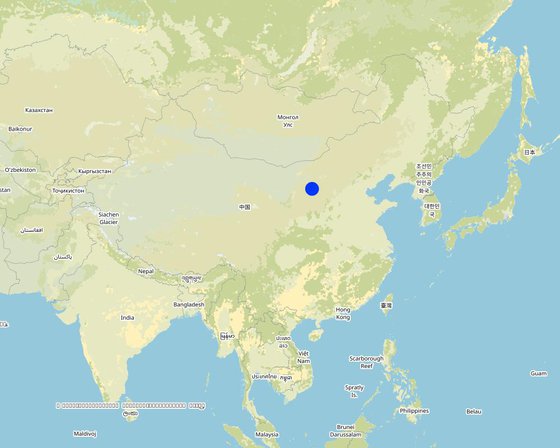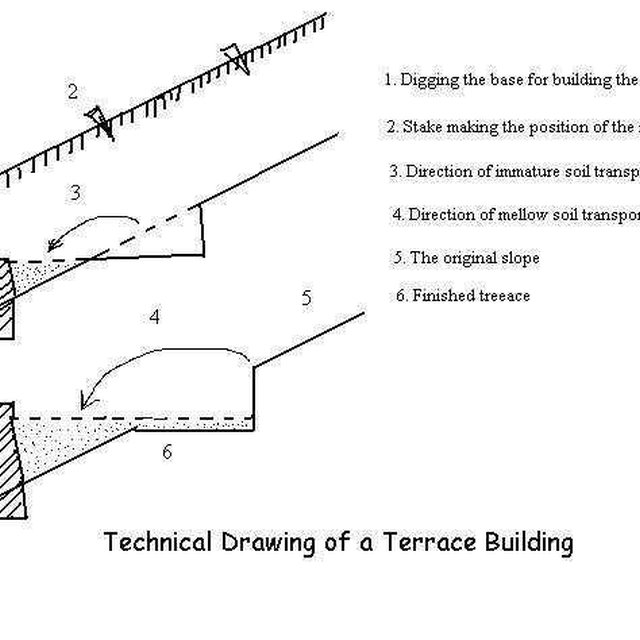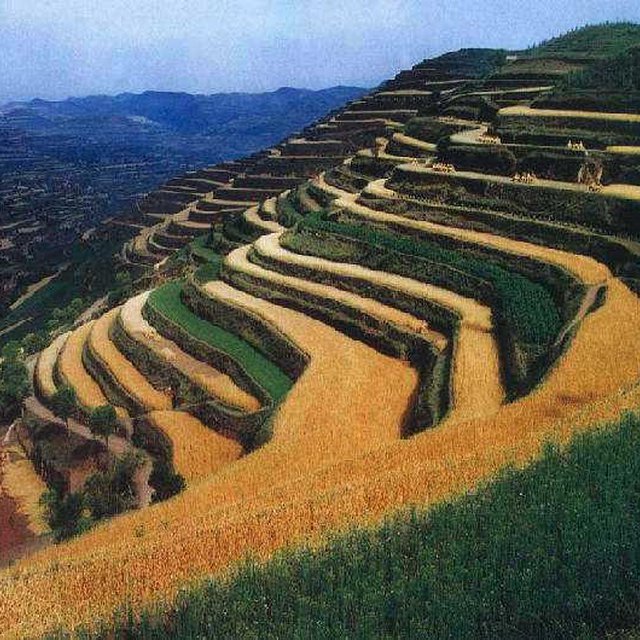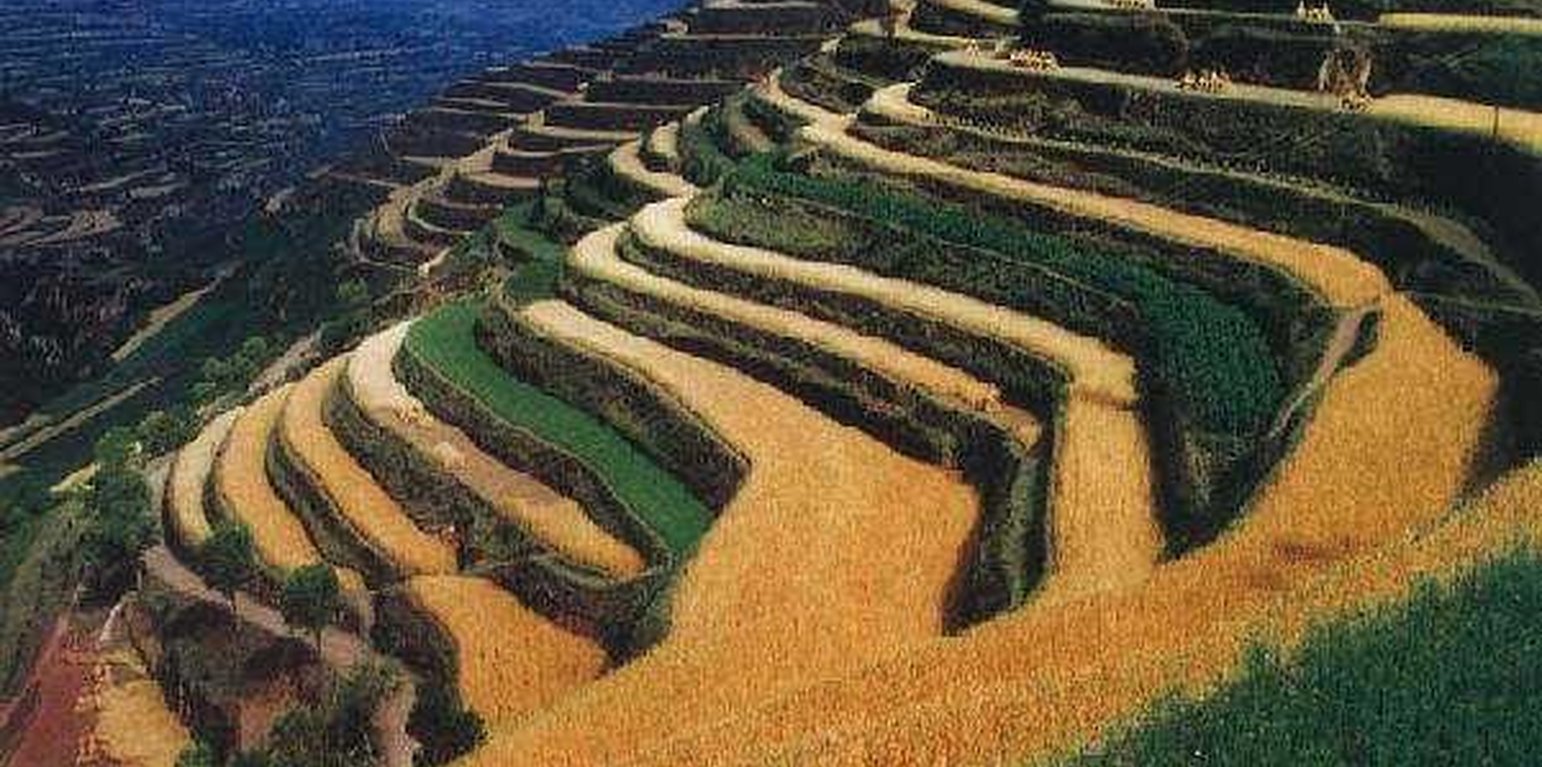Terrace
(Китай)
Описание
Terraces are built on a slope land which as a raised bank made up of earth or stone with vertical or sloping sides and an approximately flat top to control soil erosion and preserve and enhance soil fertility.
Aims / objectives: A terrace has a raised bank made up of earth or stone with vertical or sloping sides and a flat top. It can reduce slope angle and length, wrap runoff, increase infiltration and reduce soil loss. Crops can grow well because water increases in the soil. The ground cover is improved. Terraces can be constructed by manual labor or machine. Firstly, surveying the slope hills and determining width of terraces according to the slope angle and soil texture. Secondly, leveling up the slope and constructing the banks. Thirdly, maintaining. The terraces are implemented together by state, local A terrace has a raised bank of earth or stone with vertical or sloping sides and a approximately flat top. It can reduce slope angle and length, retain runoff, increase infiltration and reduce the soil loss. Crops can grow well because water increases in soils. Meanwhile, ground cover is improved. Terrace can be constructed by manual labor or machine. Firstly, determining the width of the field according to the slope angle and soil texture. Secondly, putting the topsoil aside. Thirdly, leveling up the slope and constructing banks. At last, putting the topsoil to the top of the flat surface.
Местоположение

Местоположение: Shaanxi, Shanxi, Gansu, Henan, Inner Mongolia, Китай
Географическая привязка выбранных участков
Дата ввода в действие: 1950
Дата завершения: н/п
Тип Подхода
-
традиционная/ местная система землепользования, используемая коренным населением
-
недавняя местная инициатива/ инновация
-
в рамках проекта/ программы

Technical drawings of a terrace in the Loess Plateau

Picture of terrace in the Loess Plateau
Цели подхода и благоприятные условия для его реализации
Главные цели/ задачи Подхода
The Approach focused mainly on SLM with other activities (Increasing crop yield.)
The main objectives of the approach were conserving soil and water on slope land and enhancing soil fertility.
The SLM Approach addressed the following problems: Soil loss and land degradation, lack of fund and technology.
Условия, содействующие применению Технологии/ Технологий в рамках Подхода
Условия, затрудняющие применение Технологии/ Технологий в рамках Подхода
-
Наличие/ доступность финансовых ресурсов и услуг: No enough money
Treatment through the SLM Approach: The national government partly fund, individual partly invests, local government partly invests.
-
Нормативно-правовая база (землевладение, права на земле- и водопользование): The existing land ownership, land use rights / water rights hindered a little the approach implementation The ownership of the land resources belongs to state and communities, land users can only lease the land for a period of time, they worry about their land would be transferred to others.
-
Осведомленность в области УЗП, доступность технической поддержки: Poor knowledge for how to reduce the soil loss
Treatment through the SLM Approach: Ehancing SWC specialists guidance
-
Другие: Peasant worry about that they can not own the use right.
Treatment through the SLM Approach: The national government advocates whose who invest labors who get the benefits.
Участие и распределение ролей заинтересованных сторон
Заинтересованные стороны, участвующие в реализации Подхода, и их роли
| Какие заинтересованные стороны/ организации-исполнители участвовали в реализации Подхода? |
Перечислите заинтересованные стороны |
Опишите роли заинтересованных сторон |
| местные землепользователи/ местные сообщества |
Working land users were mainly men (Men are the main force for field work.)
Existing groups of land users
Experienced peasant may be involved in introducing the local situations. |
Men know much more technical knowledge and skills than women.
If a terrace is constructed by machine, men and women are not different. If a terrace is constructed by manual labor, men can do more work. |
| эксперты по УЗП/ сельскому хозяйству |
|
|
| государственные власти (отвечающие за планирование или принятие решений) |
|
|
Участие местных землепользователей/ местных сообществ на разных стадиях реализации Подхода
нет
пассивное
внешняя поддержка
интерактивное
самоорганизация
инициирование/ мотивация
rapid/participatory rural appraisal; The approach is a traditional way to harvest water and wrap soils, SWC applied land users easy to understand and accept it if some subsidy being obtained.
планирование
interviews/questionnaires; Being involved in the planning.
выполнение
responsibility for minor steps; Being involved in the planning.
мониторинг/ оценка
reporting; No participating.
Принятие решений по выбору Технологии УЗП
Решения принимались
-
исключительно землепользователи (по собственной инициативе)
-
в основном землепользователи при поддержке специалистов по УЗП
-
все участники как часть процесса совместных действий
-
преимущественно специалисты по УЗП после консультаций с землепользователями
-
исключительно специалисты по УЗП
-
политики/ руководители
Принятие решений было основано на
-
анализ подробно описанного опыта и знаний по УЗП (принятие решений на основе подтвержденных фактов)
-
результаты исследований
-
личный опыт и мнения (незадокументированные)
Техническая поддержка, повышение компетенций и управление знаниями
Следующие мероприятия или работы являлись частью Подхода
-
Повышение компетенций/ обучение
-
Консультационные услуги
-
Институциональная (организационная) поддержка
-
Мониторинг и оценка
-
Научные исследования
Повышение компетенций/ обучение
Обучение было предоставлено следующим заинтересованным лицам
-
землепользователи
-
местный персонал/консультанты
-
extensionists/trainers, politicians/decision makers
Тип обучения
-
в ходе работы
-
обмен опытом между фермерами
-
опытные участки
-
общие собрания
-
курсы
Рассматриваемые темы
Teaching them how to design and build terraces on a slope land etc.
Консультационные услуги
Консультационные услуги были предоставлены
-
на полях землепользователей
-
в постоянно функционирующих центрах
Local government and SWC division.; Key elements: Demonstration, Visiting, Visiting; 1) Advisory service was carried out through: government's existing extension system 2) Advisory service was carried out through: government's existing extension system; Extension staff: mainly government employees 3) Target groups for extension: land users; Activities: Explain and demonstrate
Advisory service is quite adequate to ensure the continuation of land conservation activities; At each government level, there is a SWC division which is in charge of SWC activities including extension.
Институциональная поддержка
Какие институциональные структуры были укреплены или вновь созданы
-
нет
-
да, немного
-
да, умеренно
-
да, существенно
на уровне
-
местные
-
региональный
-
национальный
Опишите организацию, функции и ответственность, членство и т.д.
Тип поддержки
-
финансовая
-
повышение компетенций/ обучение
-
оборудование
Подробнее
Мониторинг и оценка
bio-physical aspects were regular monitored by 0 through measurements; indicators: None
technical aspects were regular monitored by 0 through measurements; indicators: None
socio-cultural aspects were ad hoc monitored by 0 through observations; indicators: None
economic / production aspects were regular monitored by 0 through measurements; indicators: None
area treated aspects were regular monitored by 0 through measurements; indicators: None
no. of land users involved aspects were ad hoc monitored by 0 through measurements; indicators: None
management of Approach aspects were ad hoc monitored by 0 through observations; indicators: None
There were few changes in the Approach as a result of monitoring and evaluation: None
Научные исследования
Научные исследования проводились по следующим темам
-
социология
-
экономика / маркетинг
-
экология
-
технология
Research was carried out both on station and on-farm
Финансирование и внешняя материальная поддержка
Годовой бюджет мероприятий по УЗП в долларах США
-
< 2000
-
2000-10000
-
10000-100000
-
100 000-1 000 000
-
> 1 000 000
Precise annual budget: н/п
Approach costs were met by the following donors: government (national - fund): 100.0%
Землепользователям были оказаны/предоставлены следующие услуги или меры стимулирования
-
Финансирование и внешняя материальная поддержка, предоставляемая землепользователям
-
Субсидии на отдельные затраты
-
Кредитование
-
Другие методы или инструменты стимулирования
Финансовая/ материальная поддержка, предоставленная землепользователям
профинансированы частично
профинансированы полностью
оборудование: техника: инвентарь/ инструменты
hand tools
сельскохозяйственные: семена
сельскохозяйственные: семена: удобрения
Трудозатраты, вложенные землепользователями были
-
добровольный
-
в обмен на продукты
-
за денежное вознаграждение
-
в обмен на другие материальные ресурсы
Заём/кредит
-
Условия: Interest rate charged: 0.5%
Interest was lower than market rate.
-
Кредиторы: н/п
-
Заёмщики: н/п
Анализ влияния и заключительные положения
Влияние Подхода
Нет
Да, немного
Да, умеренно
Да, существенно
Сумел ли Подход помочь землепользователям внедрить и поддерживать технологии УЗП?
Subsoiling and applying more manure and compost.
Сумел ли Подход разрешить правовые проблемы землевладения/ землепользования, препятствующие использованию технологий УЗП?
Persuading them to accept
The problem is likely to be overcome in the near future. The relationship between land ownership and use rights can be properly dealt with by government and managers.
Did other land users / projects adopt the Approach?
According to the local situation, pits and check dam etc. also adopted in the approach.
Основные причины, побуждающие землепользователей внедрять УЗП
Долгосрочная устойчивость мероприятий в рамках Подхода
Могут ли землепользователи самостоятельно (без внешней поддержки) продолжать применение того, что было реализовано в рамках Подхода?
Заключительные положения и извлечённые уроки
Сильные стороны: по мнению землепользователей
-
increase in production
-
Easier to till
Сильные стороны: по мнению составителя или ответственных специалистов
-
Reduction of the slope angle (How to sustain/ enhance this strength: Raising terrace bank.)
-
reduction of the slope length (How to sustain/ enhance this strength: Protecting terrace banks by planting trees or others.)
-
Harvest of the runoff and increase in infiltration (How to sustain/ enhance this strength: Protecting the banks)
-
increase in soil fertility and organic matter (How to sustain/ enhance this strength: Applying manure and fertilizer)
-
improvement of ground cover (How to sustain/ enhance this strength: no till with mulching.)
Слабые стороны/ недостатки/ риски: по мнению землепользователейвозможные пути преодоления
Слабые стороны/ недостатки/ риски: по мнению составителя или ответственных специалистоввозможные пути преодоления
-
Decrease in production in the first1-2 year(s)
Fertilizering plenty of manure.
-
The ridge of the terrace is possible to be destroyed by storms and rats
Repairing and maintaining in time.
Справочные материалы
Рецензент
-
David Streiff
-
Joana Eichenberger
Продолжительность применения Технологии: 28 января 2009 г.
Последнее обновление: 13 июля 2022 г.
Ответственные специалисты
-
Meili WEN (baoyuan@bnu.edu.cn) - Специалист по УЗП
-
Baoyuan Liu (baoyuan@bnu.edu.cn0) - Специалист по УЗП
Полное описание в базе данных ВОКАТ
Документирование осуществлялось при участии
Организация
- Department of Resources and Environmental Science, Beijing Normal University (Department of Resources and Environmental Science, Beijing Normal University) - Китай
Проект
Ключевые ссылки
-
Suide Water and Soil Conservation examination station of Yellow River Water Resources Committee: Corpus of Test Research of Water and Soil Conservation (the second volume), 1981 ,p130~185
-
Water and Soil Conservation Department of Yellow River Water Resources Committee of Ministry of Water Resources and Electric Power.: Corpus of economic benefits of water and soil measures, 1987, p77~102, 510~514
-
ongyinglin,Changpiguang ,Wangzhihua. Discussion on the several questions on increasing production of the terrace with two banks.: Soil and Water Conservation Science and Technology in Shanxi, 1990, No.1, p36~37.
-
Jiangdingsheng. Discussion on section design of the terrace on the Loess Plateau.: ACTA CONSERVATIONIS SOLI ET AQUAE SINICA, 1987,Vol.1,No.2, p28~35
-
Liangqichun, Changfushuang , Liming. A study on drawing up budgetary estimate quota of terraced field.: Bulletin of Soil and Water Conservation, 2001,Vol.21,No.5, p41~44
-
Liumingquan, Zhangaiqin, Liyouhua. Pattern engineering of reconstruction the slope cropland.: Soil and Water Conservation Science and Technology in Shanxi, 1992,No.3, p18~21.
-
Lixuelian,Qiaojiping. Synthetic technology of fertilizing and improving production on the new terrace.: Soil and Water Conservation Science and Technology in Shanxi, 1998,No.3,p13~14.
-
Terraces in China.: Ministry of Water Resources of China.The press of Jilin science technology , 1989






